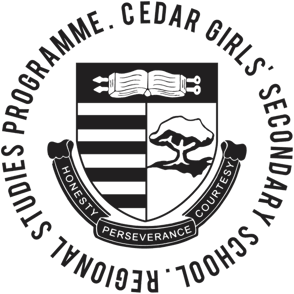Day 3 - Langkawi
We enjoyed learning about cooking 3 different dishes this morning, such as korma daging,
2024 LANGKAWI
11/7/20249 min read
Making Malay Food
Today we learnt how to make traditional Malay food such as Gulai Lemak Pucuk Ubi (Sweet potato shoot curry), Kari Daging (beef curry) and Daging Masak Kurma (meat cooked with kurma). The chef from Cafe Jebat was friendly and a very good teacher to us. we gained useful skills and knowledge on how to make these delicious dishes. Although some of us we have eaten these dishes several times, we have never seen what properly goes into making these dishes. After the chef demonstrated how to make these dishes, Yi-lin, Denis and myself (Layla) volunteered to try our hand at making Gulai Lemak Pucuk Ubi, Kari Daging and Daging Masak Kurma respectively. Although it was difficult, I (Layla) think Yi-lin and Denis did spectacularly. Afterwards, we had the staff’s rendition of the same dishes for lunch, and overall the visit proved enlightening and enriching for all of us to learn more about what goes behind Malay cuisine.
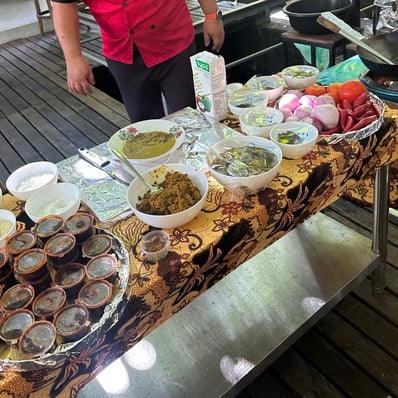
Mangroves
Langkawi has a lot of natural mangrove forests. All of them are very fascinating to see since singapore has very few mangrove areas. We are pleased to see that they managed to conserve this natural mangrove forest while constructing their restaurant. The restaurant’s good food allows greater exposure for people to the mangrove forest and educate people on the importance of conservation. We learnt from Ms Sandra that besides the presence of many islands (98 to be exact) that surrounds the mainland, the mangroves reduce the impact of the tsunami that hit Langkawi in 2004, since they act as a bio-shield. Furthermore, they help prevent coastal erosion, and act as nurseries to several species of marine life.
Ms sandra was also telling us about the history of langkawi’s name, associated with the many sightings of eagles of langkawi, and about the kapok plant, which has a material similar to cotton. lang is short for helang, meaning eagle, and kawi is a reddish-brown rock that can be easily found in the area. Langkawi has two main species of eagle, the white-bellied sea eagle and the brahminy kite. Monitor lizards often feed on the brahminy kite eggs as well. The residents used to conduct feeding eagle tours for tourists, however they realised that the eagles become conditioned to wait for food rather than hunt by themselves, so this activity was stopped. Instead, the local tour companies conduct eagle sighting ferry tours.
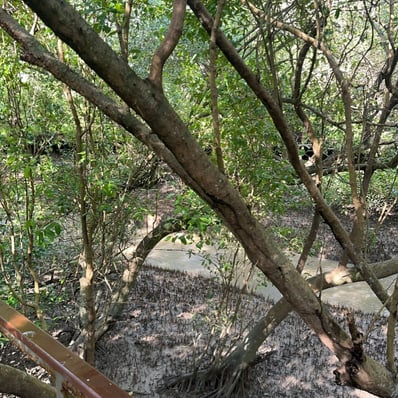
Local Arts and craft
The blue and white exterior of the museum was simply amazing! i loved the enthralling colour and the intricate design of the museum and the colour scheme was stunning but it was nothing compared to the wonderful crafts we saw inside the museum!
I loved hearing firsthand stories about the orang aslis from Ms fatimah! she shared many interesting stories about her experiences with the items in the musuem. The museum contained items often used by the orang aslis which ms fatimah was part of. we learnt about the danger of poison darts(if u do not have enough strength u might end up killing yourself!), the use of glam tree resin to seal the boat and make kitchen utensils, and how to distinguish whether the teek is from the forest or homegrown( if the colour is darker its from the forest) i learnt how orang aslis use the natural resources around them to benefit their lives which was very cool!
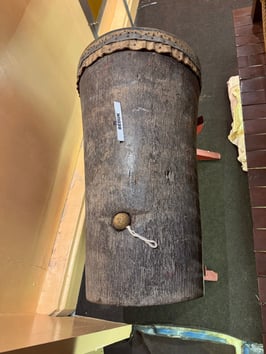

We learnt about the beduk which is an instrument and how it was made from the coconut trunk and a layer of taut and dried animal skin at one end to allow for sound to echo through the hollow trunk. It is used to alert the people of tigers as there were many tigers in singapore at that time and at the same time as a tool to alert the locals of the five prayers. The beduk is placed in the mosque which was normally located in the centre of the city.
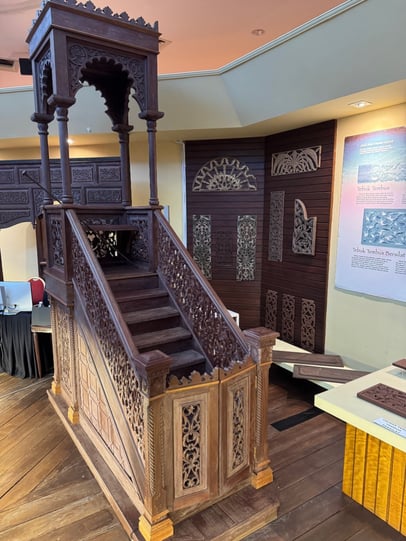

This is a real minbar with wonderful intricate carvings which were hand carved! the minbar is the place where the imam gives his sermons. I was able to visualise the imam giving his sermons here after yesterday's visit to the masjid. We also learnt that the carvings on the wood are normally flower or geometric shapes as Muslims should avoid having carvings of living things like animals in their homes.
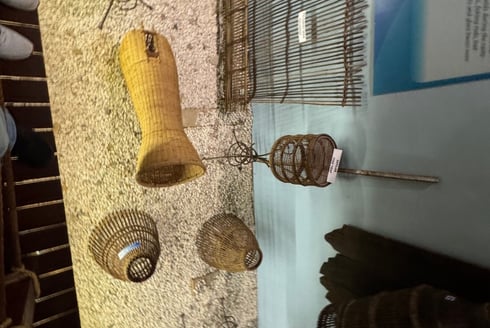

These fish traps are made of rattan. orang aslis which live in the jungle make a living of collecting rattan and bamboo and sell them to the middle man who sell them to talented craft makers who weave the rattan and bamboo to create fish traps.
Museum of Cultures and Weddings
In this museum, the wedding details of the different ethnic groups in Malaysia were displayed. The word “merisik” was often used, which we had not seen before. it is usually used to mean the first meeting of the bride and groom, to ensure both parties are available for marriage, during a time where both parties are strangers and are not in a relationship with another.
The above photo is of an ibanese wedding ceremony (who are these DIVAS 💜). it usually consists of ngayap (selecting of the b&g), babungan ka jako (memisik), nanya indu (engagement) and melah pinang (the wedding ceremony).
The kadazan wedding ceremony was also displayed in the museum. they are the largest ethnic group in sabah, also known as momogun or mamasok, meaning natives. their wedding customs consist of monohuku (merisik), momuaboi (engagement) and matod (wedding). They use a lot of copper in their items as well, like in tangkongs.
Weddings of other ethnic groups were also represented, such as the malaysian chinese and malaysian indian wedding ceremonies. they consist of much of the same rites, except for the chinese fortune-telling before the merisik. In Malay weddings, there are many features similar to the wedding of the Hindus. We learnt that the Malay Muslim community , besides the solemnisation after the engagement, the couples also typically give gifts such as food as part of their dowry. It was interesting to know that the females will always have more trays the males, which is a cultural practice.
Weddings usually use a lot of yellow, the royal colour, since the bride and groom are treated as the king and queen for a day. Eggs are usually part of the exchange of gifts, to symbolise new life and fertility for the couple.
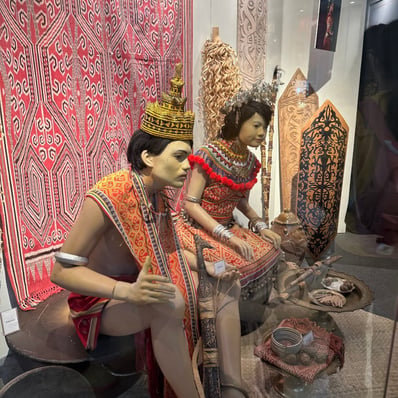
We entered the evolution craft gallery after the wedding section. this was the last section and i felt this was more modern compared to the first section which mostly consisted of wooden pieces while the pieces here consisted of wooden, brass, steel, glass, clay etc
We found this very interesting as normally, malays normally dont carve animals as they avoid doing so. however in this piece there were koi fish present. Zoie and I were quite surprised and we asked our teacher why there was a carving of animals on the box. Cikgu farah, our teacher informed us that maybe due to the piece being made in 2009 and is somewhat recent, the creator of the piece decided to carve animals on the piece as part of his thematic creative process.
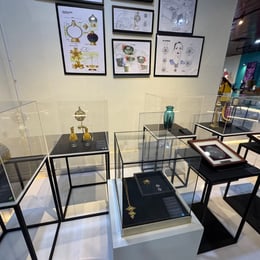
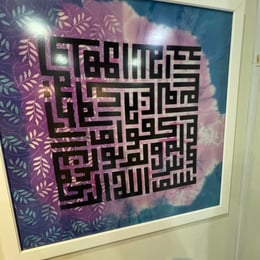
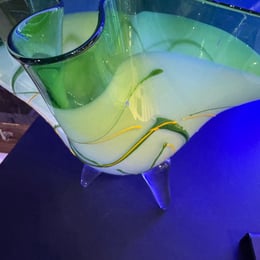
The ornamental vase is made from crystal glass blowing. it is inspired by the corals reef motif.
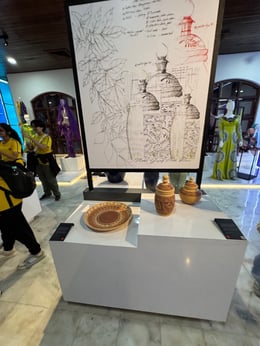
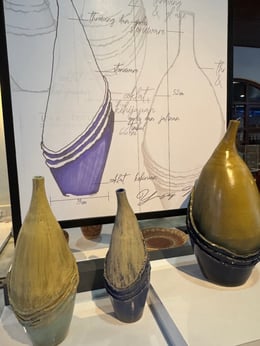
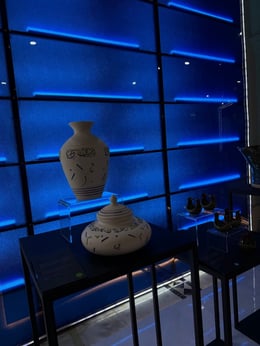



The pictures of the drawing and the thought process of the art works were simply mesmerising and really showed how detailed the behind the scenes work of the pieces were. I really appreciated the talent and understood how much effort was put into these pieces. personally, I think the drawings were an art work by themselves! I loved to see the intricate finishes on this piece. it was simple but I loved how the simple but elegant arabic letters really complimented the white and earthy texture of the vase.
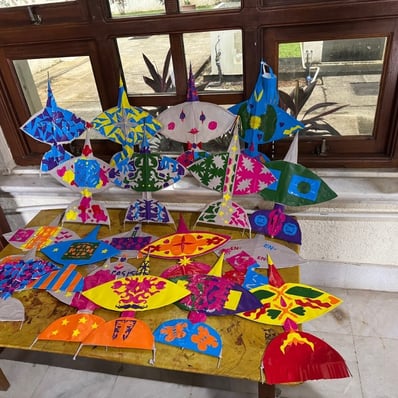
Handicraft Activity
We had the opportunity to make waus which are traditional kites. we had to cut up tracing paper to the outline of the skeleton of the kite. we then used coloured paper to decorate the kites. we also had to make intricate paper cutouts from the coloured paper to beautify the wau!
I was shocked at how talented the instructors were as they were able to do papercut designs with such ease!
Although it was tough at first, I trusted the process and eventually i was pretty proud of the end result! This was such a fun and enlightening activity that I would definitely recommend! (Not to mention we get free decor, we ATE 💜) -- this translated in formal english just means, they felt they decorated their Waus exceptionally - Ms Farah
On our way to dinner, since we were early we visited the beach which was near to the Craft Complex and in the way to our dinner venue. This beach is called the Dataran Tanjung Rhu. This beach is very clean and has rich biodiversity. There were even crab holes at the beach! The sea has many species of marine life, many of which washed up on shore as seashells. There was an ice cream cart over there, and they sold ice cream a bit differently from how they sell it in Singapore. The ice cream flavour was yam and vanilla and there was an option to put pulut (glutinous rice), peanuts and evaporated milk! It was truly fascinating to see as it is served differently in Singapore. There was another card that sold mini fish lekor in sticks!
This was interesting to see since we usually do not have these type of food sellers at our beaches since we already have shops nearby that sells food at our beaches.
Dinner and Night Market!
this is so SUGOI 💜
The night market had a bustling environment, full of diverse snacks and items. It was interesting to see many different dishes from different cultures. The atmosphere was different from that of Singapores. In Singapore, night markets are few and far between. It is a rare occasion to see night markets that only exist for the day or week. Even in the few food markets that are scattered throughout Singapore, they all sell standard trendy foods at extremely high prices. It was refreshing to see different foods at this night market! There were many traditional snacks and dishes but there was also plenty of trendy sweet treats. Best of all, they were all at super low prices (due to the exchange rate, it seems cheaper for us. but in local context, the price is just right for them to have a night out with family - Ms Farah)! I was shocked by how cheap yet delicious the dishes were.
As I walked around, i was reminded of how different yet similar Singapore and Malaysia were. There was the usual fried food and satay but I didn’t expect to see things like yong tau foo or tanghulu. I was not even aware that such things were sold in Langkawi! It was nice to see these shared cultures. Even outside of Singapore, there were dishes like sushi and burgers coming from different countries across the globe. Some of these dishes were even fusion versions of the original dish! For example, the nasi lemak sushi.I love seeing different foods from different cultures coming together to create a unique and diverse spread of food.
There were many dishes that i have never heard of before. For example, this (frightening) dish, fried mantis! I have never seen such a dish before so it was definitely a culture shock.
Another shock to me was the fact that there was live fish being sold in the night market. I don't think that that would be legal in Singapore but who am i to say! This also shows the difference in practices between Singapore and Malaysia. Each has its own unique features in the markets. Langkawi had many clothes shops selling mostly jerseys which I haven’t seen in Singapore before. In fact, all the jerseys sold in Singapore are super expensive due to the high demand for them. The prices in Langkawi were also extremely affordable and reasonable which I really appreciated (I'm broke..)
All in all, the most striking part about the night market was definitely the vibe and the locals. Although there were a few tourists (including us oops), the culture and conversations by the locals really shined through. All the sellers that I engaged with were extremely kind and offered me warm smiles. Sounds of the locals trying to bargain for a cheaper price also reminded me of home. In the end, we were once a country together. Im glad that both our countries share so many similarities in such special ways!
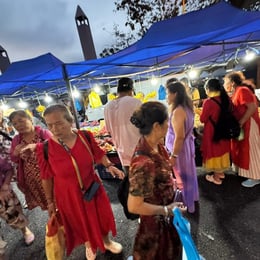
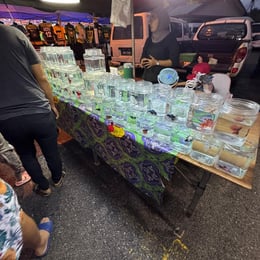
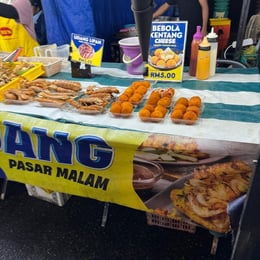
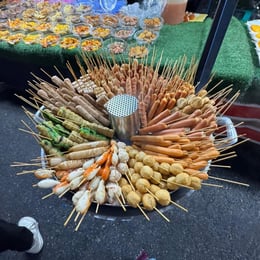
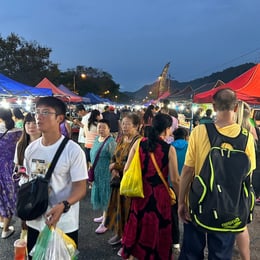
Written by:
Cooking session, Mangrove and Wedding Museum- Gurasis and Layla
Art and Crafts museum, Wau and Night Market - Zoie and Akshara
